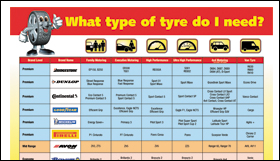Car Tyre and Van Tyres Information
Top Tips
- Check your pressures once a month
- Always check pressures when the tyres are cold (ideally when they have travelled less than 2 miles)
- Check your drivers handbook, driver’s door sill or fuel filler cap
- Increase pressures in accordance with drivers handbook when the car is fully laden i.e. when going on holiday)
- Always use a reliable pressure gauge
- Don't forget to check ALL your tyres including the spare!
- Whilst checking your pressures, also look out for signs of tread wear, cuts or other damage
- If in doubt, ask an expert.
Tyres are the only parts of your car which are in contact with the road. Safety in acceleration, braking, steering and cornering all depend on a relatively small area of road contact. It is therefore of paramount importance that your car tyres are maintained in good condition at all times and when the time comes to change them, the correct car tyre replacements are fitted.
Van tyres take a lot of punishment; they come into contact with potholes, uneven debris-filled road surfaces and can vary from multiple short journeys to long haul. For these reasons its important to choose the right van tyres for your vehicle taking into account your motoring needs. Just like car tyres, van tyres require regular maintenance to ensure they remain safe and legal for the roads. Read more about van tyres here.
Car Tyre Tread Patterns
There are many types of tyres available for motorists to choose from. As well as selecting the size, load index and speed index it is vital that the tread pattern is also considered. The tread pattern is simply the grooves found in the rubber on the circumference of the tyre. These tread patterns have been designed to improve the cars handling and traction whilst providing a comfortable ride for the motorist as well as reducing noise levels.
The patterns are divided into three categories, Symmetrical, Asymmetrical and Directional.
Symmetrical
As the name suggests, this tread pattern is symmetrical meaning the treads on the circumference of the tyres follow a uniformed design, if you cut the tyre in two lengthways you would have two identical sides. Symmetrical tyre patterns are used on passenger cars.
The symmetrical tread pattern is considered an economical one as it boasts improved tread life, meaning the tyre will take longer to wear out. These tyres are also quiet as well as fuel-efficient due to low rolling resistance. The symmetrical tread pattern means the tyres have the ability to help a vehicle to remain stable when moving.
Asymmetrical
Asymmetrical tyres feature two separate patterns on one tyre. One that runs along the inner half and the other, usually larger blocks of tread, along the circumference of the outer half of the tyre. The larger firm blocks are situated on the outer section to provide high grip when cornering. The inner tyre tread pattern has smaller groves to dissipate water and prevent aquaplaning and dispel heat from the rubber.
Asymmetrical tyres are popular with motorists with high-performance cars as they offer excellent handling and grip on wet roads.
Directional
Directional tread patterns are not dissimilar to symmetrical tyres to look at however they have been specifically engineered to only turn in one direction. These tread patterns are designed for sports cars and therefore feature outstanding steering responsiveness.
Directional tyres can only be mounted as indicated on the tyre. Each tyre will feature a small white arrow showing which axle the tyre is to be placed on as they are designed to rotate in one direction only.
Why you shouldn't mix tread patterns
Mixing tread patterns on an axle is not recommended. Each tread pattern offers different features and benefits therefore it could be dangerous to the motorists as the patterns have differing handling characteristics and may not work in unison.
Where possible try and replace tyres with identical tread patterns so the car features matching tyre designs. If this isn’t possible you should ensure that the tyres on the same axle are carrying the same tread pattern.
Related article: Tyre construction and design
Click here for a quick reference guide to the right type of tyre to meet your needs



 Sign up for SPECIAL OFFERS
Sign up for SPECIAL OFFERS
